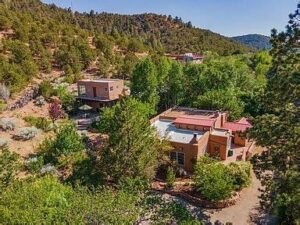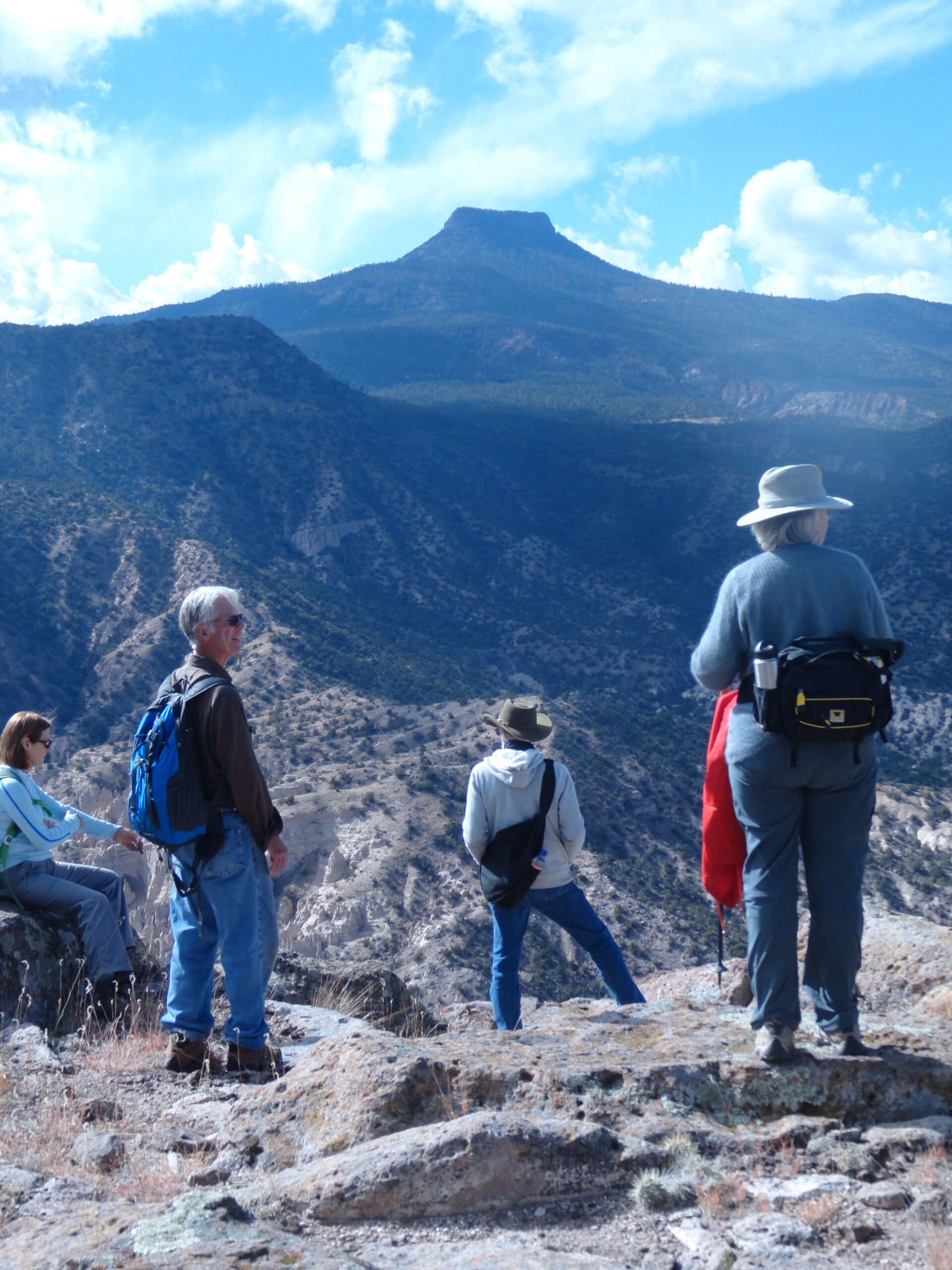It was a dark cloud covered night as I sat outside playing a drum at my Chupadero valley home north of Santa Fe in 1982. It was more like the drum was playing me–or we were in a conversation like close friends.  There was only the drum in my immediate awareness, no thoughts of conscious control or direction of the beat. A slight breeze began, then light rain. I asked whatever, whoever was listening in the darkness if I might see the moon and then watched how seemingly in response it appeared from a circular opening in the clouds. I kept drumming. A feeling of oneness with life welled up that was humbling amid this kinship with land, sky, water, air–an intimacy with the natural world I had not known fully before coming to New Mexico. The feeling was both new and anciently familiar.
There was only the drum in my immediate awareness, no thoughts of conscious control or direction of the beat. A slight breeze began, then light rain. I asked whatever, whoever was listening in the darkness if I might see the moon and then watched how seemingly in response it appeared from a circular opening in the clouds. I kept drumming. A feeling of oneness with life welled up that was humbling amid this kinship with land, sky, water, air–an intimacy with the natural world I had not known fully before coming to New Mexico. The feeling was both new and anciently familiar.
The beat abides.
Years later I learned that what happened this night in 1982 was the experience of many people in many cultures, this relationship of thought, intention and prayer between drummer, drum and the natural and noumenal world. Some say the drum was the first instrument used by humans and that it has the power to aid in healing and influence the weather. Stories about drummers being able to induce or dissuade thunder, rain and other elements through the vibrations sent into the atmosphere are common among indigenous people. https://www.youtube.com/watch?v=JPn6eZHhoo0
The Native American drum I held in my hands that night came to me through a creative performance production called Luna. I was singing as well as playing my old instrument from grade school, the clarinet. Friend Jim Berenholtz https://composers.com/composers/jim-berenholtz had composed the music and choreography for the performance based on the cycles of the moon. Singers, musicians and dancers from Taos, Santa Fe and Albuquerque joined the creative collaboration. After the performances, the one-sided Taos drums used by the dancers were for sale, and I bought one, not really knowing why or what to do with it. But the drum was calling me to listen to its voice–the language of the tree, the animal, the earth, ancient cultures of the world and my own heartbeat. Over time it has become an abiding companion on lonely nights, on Earth Walks journeys I have led throughout the American Southwest and Mexico and at monthly full moon drum circle gatherings in my home for over 20 years.
After living in Chupadero, I was fortunate to find a home in the Upper Canyon Road area of Santa Fe, near the national forest.  On a hot summer day in June 1989, I walked with friend Judy on the unpaved road from my house. Judy was and is a wise mentor and confidant and at the time a highly respected director of substance abuse programs in Santa Fe. Despite our easy-going conversation and smiles, I felt a certain sadness and slowness in my step because Judy was dealing with breast cancer. It was a huge ordeal for her, but even so she maintained a sense of hope and optimism. I wanted to help in whatever way I could, and had called her to offer a healing session with my drum.
On a hot summer day in June 1989, I walked with friend Judy on the unpaved road from my house. Judy was and is a wise mentor and confidant and at the time a highly respected director of substance abuse programs in Santa Fe. Despite our easy-going conversation and smiles, I felt a certain sadness and slowness in my step because Judy was dealing with breast cancer. It was a huge ordeal for her, but even so she maintained a sense of hope and optimism. I wanted to help in whatever way I could, and had called her to offer a healing session with my drum.
That may sound like I knew what I was doing with the drum. Yes, I had studied methods of healing through use of the drum with Michael Harner and other teachers and  experienced what are called “journeys” to other states of consciousness where I encountered “animal allies” and insights into issues with which I was wrestling. The Way of the Shaman But to help someone else? I thought it over repeatedly and drummed on my own seeking guidance. Ultimately, I felt it would be worth a try to share this with Judy during her battle with cancer. She was open to the experience.
experienced what are called “journeys” to other states of consciousness where I encountered “animal allies” and insights into issues with which I was wrestling. The Way of the Shaman But to help someone else? I thought it over repeatedly and drummed on my own seeking guidance. Ultimately, I felt it would be worth a try to share this with Judy during her battle with cancer. She was open to the experience.
As we found our way to a secluded side canyon, there were a few drops of rain among Western meadowlark warbles and cooing Mourning doves. Judy got comfortable on the ground and I sat next to her, gently drumming. I closed my eyes, letting a rhythm emerge from within, without trying to construct one. What happened next are best described in Judy’s own words which she wrote in 2014:
“...friend Doug called and wanted to do a drum healing ceremony for me. He also played the flute, a hauntingly lovely sound heard years later as it wafted over us at my 50th birthday party, five years into survivorship. He does music; comforting and healing music, lodged firmly and deeply in his unique spiritual perspective and practice. On this June day in 1989, we walked into the Audubon protected area near his house on Upper Canyon Road. A meadowlark sang to us both as we entered the soft sunny woods, and again later as we left. I laid on my back in the sun as Doug gently drummed. As I slipped away, my hawk flew, circling above me and then came down to rest near me.
What seemed to be a snarling dull gray wolf was off to my right in the trees. I was afraid as it seemed ominous and scary. My hawk flew low and fast over me, I thought to protect me from the wolf. It then landed on the wolf’s back. I was no longer afraid, as the wolf now seemed friendly and non-threatening. The wolf walked over to me, hawk on its back, and wonder of wonders, stretched out soft and warm, nurturing along my left side, with its muzzle restring on my shoulder, sweet as can be. It was incredibly touching. The hawk then spread its wings and covered my body with them while resting on my stomach. I felt safe and embraced with healing light. I remembered another time in the early days of diagnosis, while visualizing the cancer, a snarling wolf had appeared and I pushed it away as it seemed frightening. Now it seemed like an ally; what had been frightening was now a helper. Extraordinary experience; extraordinary Doug.”
I do not consider myself extraordinary, but am humbled and grateful to Judy for this extraordinary opportunity. It was a healing experience that opened some unnamable healing currents within myself as well. Our experience was testimony to the power of the drum, the power of prayer and positive intention.
In the book “Black Elk Speaks,” by John Neihardt, Oglala Sioux holy man Black Elk says this: “ Since the drum is often the only instrument in our sacred rites, I should perhaps tell you here why it is especially sacred and important to us. It is because the round form of the drum represents the whole universe and its steady strong beat is the pules, the heart, throbbing at the center of the universe, it is the voice of Wakan Tanka (Great Spirit) and this sound stirs us and helps us to understand the mystery and power of all things.” https://www.nebraskapress.unl.edu/bison-books/9780803283916/
Since the drum is often the only instrument in our sacred rites, I should perhaps tell you here why it is especially sacred and important to us. It is because the round form of the drum represents the whole universe and its steady strong beat is the pules, the heart, throbbing at the center of the universe, it is the voice of Wakan Tanka (Great Spirit) and this sound stirs us and helps us to understand the mystery and power of all things.” https://www.nebraskapress.unl.edu/bison-books/9780803283916/
It is important to know that Judy was the victor in her battle with cancer. The beat abides.





